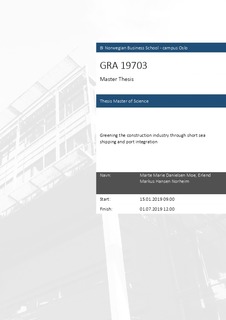Greening the construction industry through short sea shipping and port integration
Master thesis
Permanent lenke
http://hdl.handle.net/11250/2621912Utgivelsesdato
2019Metadata
Vis full innførselSamlinger
- Master of Science [1621]
Sammendrag
HeidelbergCement has enhanced their sustainable strategy and developed the
Sustainable Commitments 2030 as a response to the UN Sustainable Development
Goals. In order to reach their sustainability goals, HeidelbergCement seeks to
reduce their environmental footprint and to create long-term value for stakeholders
and society. This involves consolidation of volumes and modernisation of their
logistic system through the Sjursøya terminal in the Port of Oslo. Therefore, the
objective of this thesis is to investigate how HeidelbergCement, as a construction
material supplier, can contribute to the Green Shift in the construction industry by
modernising their distribution system through port integration. The research
question was the following: How can a construction material supplier contribute
to the Green Shift in the construction industry by changing its logistical distribution
system through port integration?
To examine this problem, different types of analytical methods are included. This
thesis has a mixed method strategy. Data was obtained through multiple in-depth
interviews with HeidelbergCement, NorBetong and the Port of Oslo. Furthermore,
a case study is used to identify and explain the resources that makes up the current
and potential future distribution systems. The effects of modernisation is quantified
and discussed in terms of economic, social and environmental sustainability.
Our findings indicate that the modernisation of distribution system contributes to
the economic, socio-political and environmental dimensions. In particular, the
modernisation has the potential to yield a reduction in emission of CO2 with 52 %,
NOx with 49 % and SO2 with 70 %. The study can be used as an example to
showcase how sea transportation and port integration can contribute to greening the
construction industry. Furthermore, our findings illuminate the role and function of
a port in a supply chain where long-term relation can facilitate for reducing
environmental footprint and sustainable securement of raw materials.
Beskrivelse
Masteroppgave(MSc) in Master of Science in Business, Logistics, operations and supply chain management - Handelshøyskolen BI, 2019
